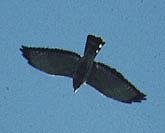Wind-surfers of the Sky
Broad-winged Hawk
Standing on a hilltop in central Panama in October, you might suddenly notice that the midday sky has gone dark. Sure, clouds have rolled in as usual during the rainy season, but this dark cloud takes on a different shape—the shape of thousands of birds!
Hawks, on their annual migration are flying over the isthmus of Panama toward wintering grounds there and in South America. Among them, the most numerous migrants are broad-winged hawks.
In 1974, Dr. Neal Smith, a researcher at the Smithsonian Tropical Research Institute in Panama, estimated that more than 30,000 broad-wings had passed overhead in a 3-hr period. Unlike most hawks, migrating broad-wings rarely use powered flight through flapping. Instead, they rely on soaring, rising up on pockets of warm air called "thermals". Soaring hawks glide from one thermal to the next to move across the landscape.
Broad-wings also are one of the only hawks to migrate in such huge flocks. Flocking may be a function of the soaring habit, and may help individual birds to locate thermals by observing where others are. Whatever the reasons, these migrating flocks provide a thrill for the human observers that gather each spring and fall at locations from Hawk Mountain Sanctuary in Pennsylvania, to Veracruz, Mexico, to Panama City and points south.
Though the spectacular migrations of broad-winged hawks have been well-studied, less is known about the rest of their ecology. They are a very common breeding hawk in the deciduous and mixed deciduous forests of eastern and central North America. Yet, most people fail to notice them as they perch quietly within the forest, waiting to pounce like a flying cat on chipmunks, voles, toads and other amphibian prey.
At the start of a breeding season, male and female broad-wings court each other with elaborate and thrilling aerobatic displays. One of these involves an avian version of a bungee jump, in which the bird plummets toward earth from a high altitude, only to veer off at the last minute before hitting the ground.
Both sexes build the nest about 25-40 feet up in the main crotch of a large deciduous or coniferous tree. They sometimes will use old nests of squirrels or crows. The female alone incubates the 2-3 eggs, but the male brings her food and sometimes incubates while the female eats. Likewise, it is the female who feeds the nestlings, with males leaving prey at the side of the nest.
You are more likely to see broad-winged hawks if you venture to their wintering grounds in Central and South America, because they tend to occupy forest edges and more open habitats. Shaded coffee plantations are particularly good wintering locations for these hawks, where they may feed more on insects like large grasshoppers and cicadas.
Unlike some other birds of prey such as bald eagles and peregrine falcons, broad-winged hawks managed to escape the effects of the pesticide, DDT.
Overall, data from the Breeding Bird Survey indicate stable or slightly increasing populations of broad-winged hawks overall between 1966-1996, although, like many other migratory birds, the species showed significant declines after 1980. Migration counts conducted at locations such as Hawk Mountain Sanctuary also have suggested possible declines since 1990.
Threats to broad-wing populations are perhaps greatest on their Latin American wintering grounds where, each year, thousands continue to be shot as perceived pests, as part of traditional folklore, or simply for sport. Additionally deforestation on the wintering range may be more extensive than on its breeding range.
As with all migratory species, threats to Broad-wings and other raptors can be present at all points along the migratory route. Steps must be taken to examine these problems and to educate people in all countries about the value of these species and the importance of conservation.
If ever you find yourself in Panama in October, keep your eyes to the sky for the "river" of migrating hawks. And, when walking through the eastern forests of North America, listen carefully for the plaintive, whistled peee-uurr of the broad-winged hawk.

